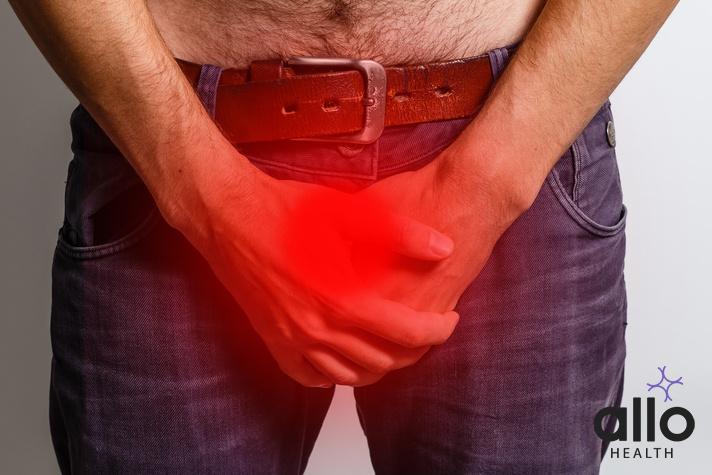Can Exposure to Radiation Cause Infertility In Males?

Allo Health is dedicated to personalized well-being, offering support and trusted information tailored to individual health goals. The platform emphasizes human-generated content, led by a distinguished medical team of experts, including physicians and sexual health specialists. Their commitment to credibility involves rigorous fact-checking, authoritative research, and continuous updates to ensure accurate, up-to-date information. Allo Health's unique approach goes beyond conventional platforms, providing expert-led insights and a continuous commitment to excellence, with user feedback playing a crucial role in shaping the platform's authoritative voice.

Dr. Aditi completed her undergraduate medical education at AJIMS, Mangalore, after which she worked in multi-speciality hospitals with COVID patients and in the Pain and Palliative medicine department. Driven by her experiences, she developed a keen interest in psychiatry. Dr. Aditi believes that mental health is just as, if not more important, than physical health.
Why This Was Upated?
Our experts continually monitor the health and wellness space, and we update our articles when new information became available.
Updated on 17 February, 2024
- Article was updated as part of our commitment to diversity, equity, and inclusion.

"The following blog article provides general information and insights on various topics. However, it is important to note that the information presented is not intended as professional advice in any specific field or area. The content of this blog is for general educational and informational purposes only.
Book consultation
The content should not be interpreted as endorsement, recommendation, or guarantee of any product, service, or information mentioned. Readers are solely responsible for the decisions and actions they take based on the information provided in this blog. It is essential to exercise individual judgment, critical thinking, and personal responsibility when applying or implementing any information or suggestions discussed in the blog."
Radiation is a form of energy that can cause damage to our bodies. Whether it comes from the sun, medical procedures or nuclear accidents, exposure to radiation can have serious effects on human health. One area where radiation can cause significant damage is in male fertility. In this article, we will explore the relationship between radiation exposure and male infertility, discussing how radiation can affect sperm quality and quantities, testosterone levels and other factors contributing to male infertility.
What Is Radiation?
Radiation refers to the emission and transmission of energy in the form of waves or particles through space or a material medium. This energy can take various forms, including electromagnetic waves (such as light and radio waves) or particle radiation (such as alpha and beta particles, neutrons, and protons). Radiation is a natural phenomenon and is present all around us. It can be categorized into two main types: ionizing and non-ionizing radiation.
- Ionizing Radiation:
- Ionizing radiation carries enough energy to ionize atoms and molecules by removing electrons from them. This process can result in the formation of charged particles (ions) and can have biological implications.
- Types of ionizing radiation include:
- X-rays: Generated artificially for medical and industrial purposes.
- Gamma rays: Emitted during nuclear reactions and radioactive decay.
- Alpha particles: Consist of two protons and two neutrons; emitted by certain types of radioactive materials.
- Beta particles: High-energy electrons or positrons emitted during radioactive decay.
- Neutrons: Subatomic particles found in the nucleus of atoms.
- Non-Ionizing Radiation:
- Non-ionizing radiation has less energy and does not have enough power to ionize atoms or molecules.
- Examples include:
- Radiofrequency (RF) radiation: Used in telecommunications, including radio and television broadcasting, as well as cell phones.
- Microwaves: Used for cooking and in various communication technologies.
- Infrared radiation: Associated with heat, commonly used in heat lamps and sensors.
- Visible light: The range of electromagnetic radiation visible to the human eye.
- Ultraviolet (UV) radiation: Beyond the visible light spectrum, commonly associated with sunlight.
Radiation is a natural part of our environment, and many sources emit radiation in various forms. The sun, for example, emits a wide spectrum of electromagnetic radiation, including visible light and ultraviolet rays. Human-made sources of radiation include medical devices like X-ray machines, nuclear power plants, and certain industrial processes.
While radiation has numerous beneficial applications, it can also pose health risks. Exposure to high levels of ionizing radiation can damage living tissues and increase the risk of cancer. Therefore, the use of radiation is carefully regulated in medical, industrial, and environmental contexts to ensure safety and minimize potential harm.

Effects Of Radiation on Male Fertility
The effects of radiation on male fertility can vary depending on the type of radiation, the dose, and the duration of exposure. Here are some key considerations regarding how radiation may impact male reproductive health:
- Ionizing Radiation:
- Testicular Damage: The testicles are particularly sensitive to ionizing radiation. High doses can damage the germ cells (sperm-producing cells) in the testes, leading to temporary or permanent infertility.
- Sperm Production: Radiation exposure can affect sperm production (spermatogenesis) and quality. It may result in a decrease in sperm count, motility, and morphology.
- Sterility: In extreme cases, high doses of ionizing radiation may cause permanent sterility, meaning the affected individual may be unable to father children.
- Medical Radiation:
- Radiation Therapy: Cancer treatments involving radiation therapy can impact the reproductive organs if they are in the treatment field. Techniques like testicular shielding or sperm banking before treatment may be considered to preserve fertility.
- Diagnostic Imaging: Certain medical diagnostic procedures, such as pelvic or abdominal X-rays, may expose the testes to radiation. While the doses are usually low, repeated exposures or high doses can have cumulative effects.
- Occupational Exposure:
- Occupational Hazards: Individuals working in occupations where exposure to radiation is possible, such as radiographers, nuclear industry workers, or military personnel, may face increased risks to their reproductive health.
- Protective Measures: Proper radiation protection measures, including the use of shielding and adherence to safety guidelines, can help mitigate the risks associated with occupational exposure.
- Environmental Exposure:
- Radiation Accidents: Accidents involving the release of radioactive materials into the environment can pose a risk to reproductive health. Communities near nuclear facilities or affected by nuclear accidents may experience long-term health concerns.
- Chronic Low-Dose Exposure: Long-term exposure to low levels of radiation, such as those found in certain occupational or environmental settings, may have subtle effects on sperm quality and fertility.
- Preventive Measures:
- Protective Clothing: Wearing protective clothing and using shielding devices can help minimize radiation exposure in occupational settings.
- Education and Counseling: Individuals undergoing medical treatments involving radiation should receive counseling on potential fertility effects and options for preserving reproductive health.
It’s important to note that the impact of radiation on male fertility can vary among individuals, and factors such as age, overall health, and genetic susceptibility may play a role. If concerns about radiation exposure and fertility arise, individuals should consult with healthcare professionals, including reproductive specialists, to discuss potential risks and preventive measures.
Can Exposure to Radiation Cause Infertility In Males?
Exposure to radiation, particularly ionizing radiation, can have profound effects on male fertility. Understanding the causes, potential treatments, and preventive measures is crucial in assessing and addressing these concerns.
Testicular Damage:
- Causes: High-energy ionizing radiation, such as X-rays and gamma rays, can cause direct damage to the DNA within cells, including the germ cells responsible for sperm production. This damage can disrupt the delicate process of spermatogenesis, leading to abnormalities in sperm.
- Treatment: Treatment options for radiation-induced testicular damage are limited. In cases of temporary infertility, cessation of exposure may allow for some recovery. But, permanent damage may necessitate assisted reproductive technologies (ART) such as in vitro fertilization (IVF) or intracytoplasmic sperm injection (ICSI).
Effects on Sperm Quality:
- Causes: Radiation exposure can lead to a decline in sperm count, motility, and morphology. This decline in sperm quality may result in reduced fertility or infertility.
- Treatment: Fertility treatments, including ART, may be recommended to overcome challenges related to impaired sperm quality. Additionally, lifestyle modifications, such as adopting a healthy diet and avoiding exposure to other environmental factors that may impact sperm health, can be considered.
Sterility:
- Causes: High doses or prolonged exposure to ionizing radiation can potentially cause permanent sterility by irreversibly damaging the germ cells in the testes.
- Treatment: In cases of permanent sterility, alternative family-building options such as sperm donation or adoption may be explored. Counseling and psychological support are crucial for individuals navigating these challenges.
Medical Radiation:
- Causes: Radiation therapy for cancer treatment, especially when directed at the pelvic or abdominal region, can affect the testes and compromise spermatogenesis.
- Treatment: Prior to radiation therapy, healthcare providers may discuss fertility preservation options, such as sperm banking. This involves collecting and freezing sperm for future use, providing a potential pathway to fathering biological children after treatment.
Occupational and Environmental Exposure:
- Causes: Individuals working in occupations with potential radiation exposure, such as radiographers or nuclear industry workers, may face increased risks to their reproductive health. Environmental exposure, whether from nuclear accidents or chronic low-level exposure, can also pose risks.
- Preventive Measures: The use of protective measures, including shielding and proper clothing, is crucial in occupational settings. Regular monitoring of radiation levels and adherence to safety guidelines are essential for minimizing risks. In cases of environmental exposure, public health measures and ongoing monitoring are critical.
While exposure to radiation can indeed impact male fertility, early awareness, preventive measures, and informed decision-making can help mitigate risks and explore appropriate interventions for those affected. Collaborative efforts between healthcare providers, fertility specialists, and individuals are essential in navigating the complex landscape of radiation and male reproductive health.
Prevention Of Effects Of Radiation On Male Fertility
Preventing or minimizing the effects of radiation on male fertility involves a combination of protective measures, awareness, and proactive decision-making. Here’s a detailed look at various aspects of prevention:
Protective Measures in Occupational Settings:
- Radiation Shielding: Individuals working in occupations with potential radiation exposure, such as radiographers, should use appropriate shielding devices and protective clothing to minimize direct exposure to ionizing radiation.
- Education and Training: Comprehensive education and training programs for workers in radiation-prone environments are essential. This includes awareness of safety protocols, proper use of protective equipment, and understanding potential reproductive health risks.
Monitoring and Compliance:
- Regular Radiation Monitoring: Implementing routine monitoring of radiation levels in occupational settings ensures that exposure remains within acceptable limits. This proactive approach helps identify any deviations promptly.
- Adherence to Safety Guidelines: Strict adherence to established safety guidelines and protocols is crucial. This includes the proper use of equipment, maintaining safe distances from radiation sources, and following recommended exposure limits.
Fertility Preservation in Medical Treatments:
- Pre-Treatment Counseling: Individuals undergoing medical treatments involving radiation, such as cancer patients, should receive comprehensive counseling regarding potential impacts on fertility. This discussion should cover available fertility preservation options and their benefits.
- Sperm Banking: Sperm cryopreservation, commonly known as sperm banking, allows men to preserve their sperm before undergoing radiation therapy or other medical treatments. This ensures the availability of viable sperm for assisted reproductive technologies (ART) after treatment.
Environmental Monitoring and Regulation:
- Radiation Standards: Governments and regulatory bodies play a vital role in establishing and enforcing radiation standards for both occupational and environmental exposure. Stringent regulations help protect communities from potential hazards associated with radiation.
- Emergency Preparedness: In areas near nuclear facilities, robust emergency preparedness plans should be in place to address any accidental releases of radioactive materials promptly. This includes public awareness campaigns and regular drills.
Lifestyle Modifications:
- Healthy Habits: Adopting a healthy lifestyle can contribute to overall reproductive health. This includes maintaining a balanced diet, staying physically active, and avoiding smoking and excessive alcohol consumption.
- Avoiding Other Environmental Hazards: Minimizing exposure to additional environmental factors that can impact fertility, such as certain chemicals and pollutants, is crucial. This holistic approach helps protect reproductive health from multiple potential stressors.
Research and Innovation:
- Advancements in Technology: Continued research and development in radiation technology aim to minimize collateral damage to surrounding tissues during medical treatments. Innovations in treatment delivery methods can help reduce the impact on reproductive organs.
- Alternative Therapies: Investigating alternative therapies that are less harmful to fertility without compromising treatment efficacy is an ongoing area of research.
The prevention of the effects of radiation on male fertility requires a multifaceted approach that includes protective measures, education, early intervention, and ongoing research. By implementing these strategies, individuals, healthcare providers, and regulatory bodies can work collaboratively to safeguard male reproductive health in the presence of potential radiation exposure.

Other Effects Of Radiation On The Human Body
Radiation exposure can have a range of effects on the human body, depending on factors such as the type of radiation, dose, duration of exposure, and the part of the body exposed. Here’s a detailed exploration of various effects:
Skin Effects:
- Erythema (Radiation Burns): High doses of ionizing radiation can cause skin reddening, known as erythema or radiation burns. This effect is more common with external exposure and is used as a basis for radiation dose limits in occupational settings.
Acute Radiation Syndrome (ARS):
- Nausea, Vomiting, and Diarrhea: High doses of radiation received over a short period can lead to ARS. Symptoms may include nausea, vomiting, and diarrhea, typically occurring within hours to days after exposure.
- Hematopoietic Syndrome: Damage to bone marrow can result in a drop in blood cell counts, leading to anemia, increased susceptibility to infections, and bleeding.
Long-Term Health Effects:
- Cancer: Ionizing radiation is a known carcinogen. Prolonged exposure increases the risk of developing various cancers, including leukemia, thyroid cancer, breast cancer, and lung cancer, depending on the organs affected.
- Genetic Effects: High doses of radiation can cause genetic mutations, potentially leading to hereditary disorders in future generations.
Radiation-Induced Thyroid Disorders:
- Iodine Uptake: The thyroid gland is susceptible to radiation, particularly radioactive iodine. Exposure can lead to an increased risk of thyroid disorders and cancer due to the accumulation of radioactive iodine in the thyroid.
Cardiovascular Effects:
- Increased Risk of Cardiovascular Diseases: Some studies suggest that high doses of radiation may contribute to an increased risk of cardiovascular diseases, such as heart attacks and strokes, potentially due to damage to blood vessels.
Central Nervous System Effects:
- CNS Radiation Syndrome: High doses of radiation to the central nervous system can lead to neurological symptoms, including confusion, seizures, and cognitive impairment. This is more relevant in the context of therapeutic radiation to the brain.
Radiation Cataracts:
- Lens Opacities: Exposure to ionizing radiation, especially in the form of X-rays or cosmic rays, can increase the risk of developing cataracts. The lens of the eye is particularly sensitive to radiation-induced damage.
Reproductive Effects:
- Fertility Concerns: Apart from effects on male fertility, radiation exposure can impact female reproductive health. High doses may lead to menstrual irregularities, premature menopause, and an increased risk of birth defects.
Chronic Radiation Dermatitis:
- Delayed Skin Effects: Chronic exposure to lower doses of radiation may cause delayed skin effects, including dermatitis. This condition can manifest as dryness, redness, and ulceration of the skin over time.
Psychosocial Effects:
- Radiophobia: Fear of radiation, known as radiophobia, can have psychological effects on individuals exposed or at risk of exposure. This fear may impact mental health, leading to anxiety and stress.
The effects of radiation on the human body are diverse and can range from acute symptoms to long-term health consequences. Understanding these effects is crucial for establishing safety guidelines, implementing preventive measures, and providing appropriate medical interventions for those exposed to radiation.
Most Asked Questions
-
How does radiation affect male fertility?
Radiation, particularly ionizing radiation, can damage the DNA within cells, including the germ cells responsible for sperm production in the testes. This damage can lead to a decline in sperm quantity, quality, and motility, potentially causing infertility.
-
Are there preventive measures for minimizing the impact of radiation on male fertility?
Protective measures, including the use of shielding devices and proper clothing, can help reduce radiation exposure in occupational settings. Additionally, individuals undergoing medical treatments involving radiation can explore options like sperm banking to preserve reproductive potential.
-
Is the impact of radiation on male fertility reversible?
The severity of the impact depends on factors such as the dose, duration of exposure, and the specific stage of spermatogenesis affected. While some individuals may experience partial recovery of sperm production, high doses or prolonged exposure can lead to permanent infertility. It's crucial to consider these factors in assessing the potential for recovery.
-
Can medical treatments involving radiation impact male fertility?
Yes, radiation therapy for cancer treatment, especially when directed near the pelvic or abdominal region, can affect the testes and disrupt spermatogenesis. Prior to such treatments, healthcare providers may discuss fertility preservation options with patients.
-
What types of radiation are concerning for male fertility?
Ionizing radiation, such as X-rays, gamma rays, alpha particles, and beta particles, poses the greatest risk to male fertility. These high-energy forms of radiation have the potential to cause damage to reproductive tissues.






































